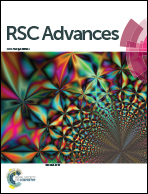Manipulating the Raman scattering rotation via magnetic field in an MoS2 monolayer†
Abstract
Magneto-optical effects, which originate from the interactions between light and magnetism, have provided an important way to characterize magnetic materials and hosted abundant applications, such as light modulators, magnetic field sensors, and high-density data storage. However, such effects are too weak to be detected in non-magnetic materials due to the absence of spin degree of freedom. Here, we demonstrated that applying a perpendicular magnetic field can produce a colossal Raman scattering rotation in non-magnetic MoS2, for A-mode representing the out-of-plane breathing vibration. Our experimental results show that linearly polarized scattering light is rotated by ∓125°, more apparent than the valley Zeeman splitting effect (∓1.2 meV) under the same experimental conditions (±5 T), near room temperature. A detailed and systematic analysis on the polarization-resolved magnetic field-dependent micro-zone Raman intensity offers a feasible way to manipulate the inelastically scattered light via a magnetic technique. This explored phenomenology and physical mechanism arouse a new ramification of probing burgeoning magneto-optical effects in the field of two-dimensional laminar materials.



 Please wait while we load your content...
Please wait while we load your content...